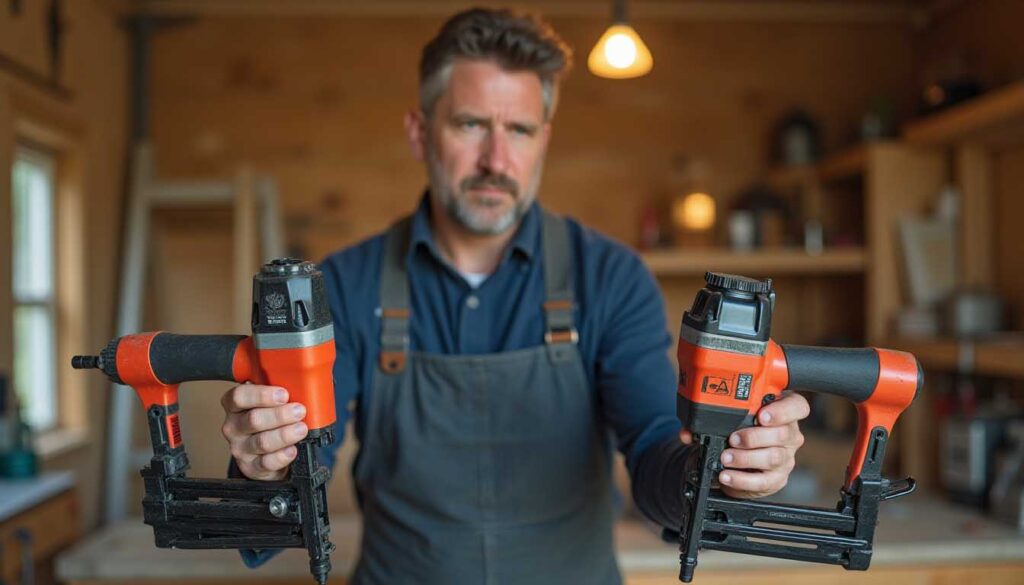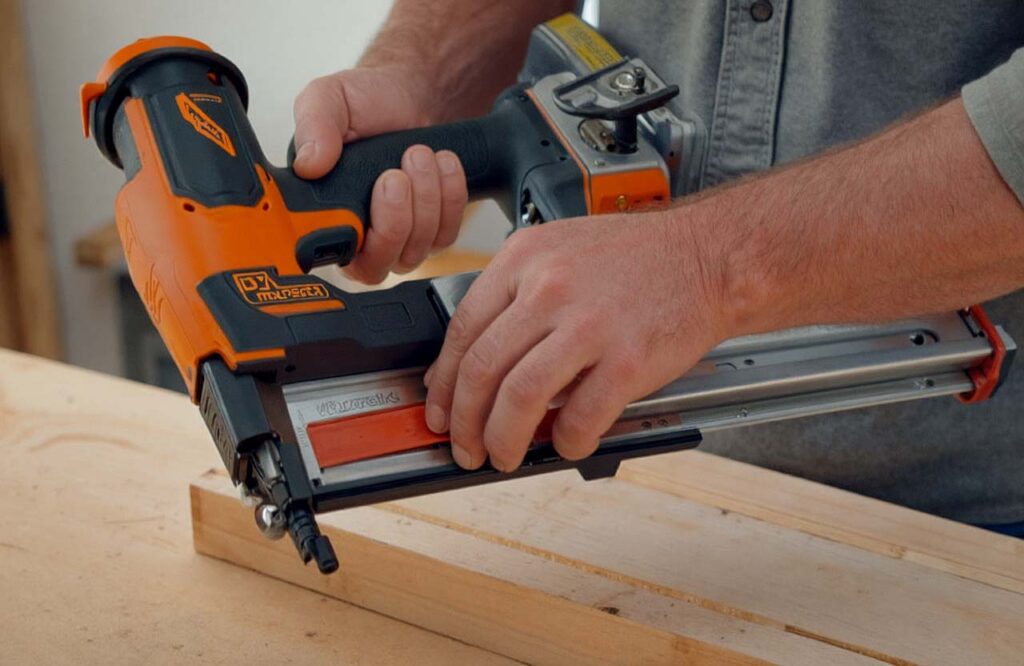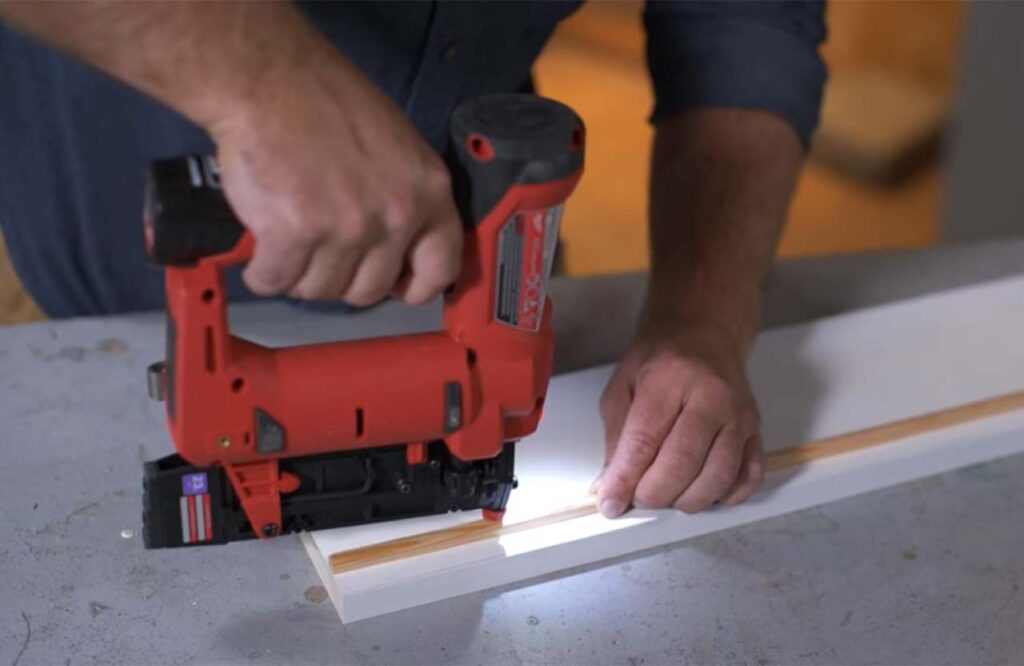If you’re diving into the world of finish carpentry or simply trying to upgrade your home tool kit, you’ve probably run into the question: 15 ga vs 16 ga finish nailer—what’s the big deal? They might seem like twins at a glance, but each of these tools comes with its own set of strengths, quirks, and ideal use cases.
Picking the right one isn’t just about numbers—it’s about matching the tool to your project’s demands. So, let’s break it all down.

Understanding Nail Gauge: What Does It Mean?
So, what does “gauge” even mean in nailer terms?
In simple words, gauge refers to the thickness of the nail. The lower the number, the thicker the nail. That’s why a 15 gauge nail is thicker than a 16 gauge nail. Seems backward? You’re not alone—this trips up a lot of people!
- 15 gauge nails = thicker, stronger nails (approximately 1.8mm thick)
- 16 gauge nails = slightly thinner nails (around 1.6mm thick)
This small difference makes a big impact on:
- How much weight the nail can hold
- How visible the nail hole is after installation
- What materials it can go through cleanly

Understanding Finish Nailers
Finish nailers are the unsung heroes of carpentry and trim work. Unlike their rough framing cousins, finish nailers are designed for precision and clean aesthetics. They shoot small-headed nails that are nearly invisible once installed—perfect for baseboards, trim, door casings, crown molding, and more.
Purpose Of Finish Nailers
Finish nailers secure wood pieces with minimal visible markings. They help in creating a smooth and polished appearance. They are ideal for detailed woodworking tasks.
- Trim work: Installing baseboards and crown molding.
- Cabinetry: Assembling and installing cabinets.
- Furniture: Building and repairing furniture pieces.

Common Types
There are several types of finish nailers:
- Angled Finish Nailers: Designed to fit into tight corners.
- Straight Finish Nailers: More balanced and better for general trim.
- Pneumatic Finish Nailers: Powered by an air compressor, offering consistent power.
- Cordless Finish Nailers: Battery-powered, highly portable but slightly heavier.
Finish nailers also come in different gauges, and that’s where our main comparison begins.
| Types | Description |
|---|---|
| 15 Gauge Finish Nailer | Uses thicker nails for strong holding power. Ideal for heavy trim and furniture. |
| 16 Gauge Finish Nailer | Uses slightly thinner nails. Suitable for medium to light trim work. |
| 18 Gauge Brad Nailer | Uses very thin nails. Perfect for delicate trim and detailed work. |
Choosing the right finish nailer depends on the project’s requirements. Thicker nails offer more strength, while thinner nails provide a cleaner finish.
15 Gauge Finish Nailer: Features, Pros, and Cons
The 15Ga finish nailer uses nails that are 1.75 to 2.5 inches long. These nails are thicker and provide a stronger hold than 16Ga nails. The 15Ga nailer typically uses an angled magazine, which allows for better access in tight spaces.

Key Features
- Typically uses angled nails (DA style)
- Nail length: 1-1/4” to 2-1/2”
- Stronger holding power due to thicker nail shaft
- Leaves larger nail holes, which might need filling
Best Use Cases
- Crown molding: They can handle the weight and stress of large moldings.
- Door casings: Ensures a firm attachment to the frame.
- Window trim: Suitable to attaceh trim without leaving nail marks.
- Baseboards: The thicker nails provide a secure hold.
- Heavy MDF or hardwood trim: Competent to hold them tight.
- Furniture Construction: Ideal for assembling heavy furniture pieces.
Pros
- Superior holding strength
- Great for structural trims and heavy-duty finish work
- Angled nose fits into tight corners
Cons
- Heavier tool
- Bulkier nails
- Larger nail holes that require puttying
- Usually more expensive
16 Gauge Finish Nailer: Features, Pros, and Cons
16 gauge finish nailers are popular among professionals and DIY enthusiasts. They provide a balance between strength and finesse. These nailers are lighter and easier to handle than their 15-gauge counterparts.
The nails used are 1/16 inch thick, making them less prone to splitting wood. Most 16 gauge finish nailers can drive nails ranging from 1 inch to 2.5 inches long. This makes them suitable for a wide range of applications.

Key Features
- Shoots slightly thinner straight nails
- Nail length: 3/4” to 2-1/2”
- Better for delicate trim and clean finish
Best Use Cases
- Base and shoe molding: Ideal for installing baseboards, crown and shoe molding.
- Chair rails: Perfect for installing chair rails without spliting and leaving marks.
- Cabinet and fine woodworking: Great for building and installing cabinets and DIY woodworking, ensuring a clean finish.
- Furniture Making: Suitable for making furniture pieces that need sturdy joints.
- Paneling: Perfect for attaching paneling to walls without splitting the wood.
Pros
- Lighter tool, easier to maneuver
- Smaller nail holes, cleaner aesthetic
- More versatile for general finishing tasks
- Ideal for DIY projects
Cons
- Slightly less holding power
- May not perform well with very dense hardwoods
- Not ideal for thick or heavy trims
Key Differences Between 15 Gauge and 16 Gauge Finish Nailers
Let’s spotlight the critical differences that could sway your decision:
| Feature | 15 Gauge | 16 Gauge |
|---|---|---|
| Nail Thickness | Thicker (1.8mm) | Thinner (1.6mm) |
| Holding Strength | Stronger | Moderate |
| Nail Hole Size | Larger | Smaller |
| Tool Size | Heavier, angled | Lighter, straight |
| Application | Heavy trim, baseboards | Light trim, cabinetry |
| Flexibility | Less, but stronger | More versatile |
| Price | Usually higher | More budget-friendly |
When to Use a 15 Gauge Finish Nailer?
Think of the 15 gauge nailer as a bodybuilder—strong, powerful, and built for heavy lifting. Here’s when it shines:
- Installing baseboards on slightly uneven walls where extra holding power matters
- Working with crown molding or thick window/door casing
- Securing MDF trim, especially if the boards are prone to pulling away over time
- Tackling hardwood trims like oak or hickory
Its angled nose also makes it perfect for tight corners and awkward angles, which would be a headache with a straight nailer.
When to Use a 16 Gauge Finish Nailer?
The 16 gauge finish nailer is the nimble gymnast—precise, elegant, and quick on its feet.
Use it for:
- Light trim around windows and doors
- Chair rails and wainscoting
- Cabinet installation and delicate woodworking
- Picture frame molding, beadboard, and paneling
Because the nail holes are smaller, you’ll spend less time filling and sanding, which is a big plus for projects where finish quality matters most.
Comparison: 15 Ga vs 16 Ga Finish Nailers
1. Nail Thickness & Strength
- 15 Gauge: Nails are approximately 0.072 inches in diameter. Ideal for heavy-duty trim, baseboards, and crown molding. The extra thickness provides more holding power.
- 16 Gauge: Nails are about 0.0625 inches in diameter. Still strong, but slightly more flexible and less supportive for heavy trim.
Winner for strength: 15 Gauge
2. Nail Length
- 15 Gauge: Typically supports nails from 1-1/4″ to 2-1/2″.
- 16 Gauge: Commonly supports 1″ to 2-1/2″.
Both offer similar maximum lengths, but the 15 gauge’s thicker nails can better support longer fasteners.
3. Angle of Magazine
- 15 Gauge: Usually has an angled magazine (typically around 34°), allowing better access in tight corners or complex angles.
- 16 Gauge: Often available in both straight and angled configurations, but the straight models are more common and less expensive.
Winner for tight spots: 15 Gauge (angled design)
4. Hole Size and Finish
- 15 Gauge: Leaves larger holes, which may require more wood filler, especially on visible surfaces.
- 16 Gauge: Smaller holes mean less patching and a cleaner finish for fine detail work.
Winner for aesthetics: 16 Gauge
5. Material Compatibility
- 15 Gauge: Best for heavy trim, hardwoods, door casings, and large baseboards.
- 16 Gauge: Suited for lighter moldings, paneling, and more delicate interior finish work.
Winner for versatility: 16 Gauge (especially for lighter applications)
6. Tool Weight and Maneuverability
- 15 Gauge: Heavier and often bulkier due to the angled magazine and thicker components.
- 16 Gauge: Lighter and often easier to handle for extended use.
A lighter tool is often better for small hands. This makes the 16-gauge nailer a popular choice for detailed work. The 15-gauge nailer, being heavier, is better for tasks requiring more power.
Winner for ease of use: 16 Gauge
7. Cost and Availability
- 15 Gauge: Generally more expensive, both for the nailer and the nails.
- 16 Gauge: More common, more affordable, and nails are readily available at most hardware stores.
Winner for cost-conscious buyers: 16 Gauge
8. Versatility in Nail Types
- 15 Gauge: Usually uses angled nails with a D-head, limiting options slightly.
- 16 Gauge: Uses straight nails that are compatible with a broader range of tools.
Winner for versatility: 16 Gauge
Summary Table: 15 Gauge Finish Nailer vs 16 Gauge
| Feature | 15 Gauge Finish Nailer | 16 Gauge Finish Nailer |
|---|---|---|
| Nail Diameter | Thicker (~0.072″/1.8mm) | Thinner (~0.0625″/1.6mm) |
| Holding Power | Stronger | Moderate |
| Hole Size | Larger | Smaller |
| Nail Length Range | 1-1/4″ to 2-1/2″ | 1″ to 2-1/2″ |
| Magazine Angle | Typically angled (34°) | Usually straight |
| Best For | Doors, casings, large trim | Panels, trim, cabinetry |
| Tool Weight | Heavier | Lighter |
| Cost | Higher | Lower |
| Finish Appearance | Needs more filling | Cleaner finish |
| Price | More expensive | Budget-friendly |
Choosing the Right Finish Nailer: A Buyer’s Guide
Before you hit the checkout button, consider these factors:
- Project Type: Heavy trim = 15 gauge. Light or detailed work = 16 gauge.
- Nail Hole Size: If aesthetics matter more than strength, go with the 16 gauge.
- Tool Weight: Need to work all day or in awkward spaces? Lighter is better.
- Budget: 16 gauge nailers (and nails) are generally cheaper.
- Tool Compatibility: Make sure your compressor or battery setup supports the tool.
- Future Needs: Think long-term—will you expand into cabinetry, furniture, or baseboard-heavy projects?
Still can’t decide? Many pros own both and switch depending on the task.
Is a 15 16 or 18-Gauge Nailer for Baseboards?
For baseboards, 15 or 16-gauge nailers are best:
- 15-gauge: Best for thicker, heavier baseboards; stronger hold.
- 16-gauge: Suitable for most standard baseboards; good balance of strength and smaller holes.
- 18-gauge (brad nailer): Not ideal for baseboards—less holding power, better for trim or delicate work.
Recommendation: Use 16-gauge for most baseboard installations.
What Gauge Nails Do Finish Nailers Typically Use?
Finish nailers typically use 15 or 16-gauge nails:
15-gauge: Thicker nails with strong holding power, often used for heavy trim, baseboards, and door casings.
16-gauge: Slightly thinner nails, good for most finish work like crown molding, casing, and baseboards.
They are not to be confused with 18-gauge brad nailers, which are used for lighter, more delicate trim work.
Can You Use 15-Gauge Nails for Framing?
No, 15-gauge nails are not suitable for framing.
Framing requires much stronger, thicker nails—typically 8d to 16d nails (about 0.131″–0.162″ diameter), driven by a framing nailer.
15-gauge nails (~0.072″) are designed for finish carpentry like trim, baseboards, and moldings—not structural applications. Using them for framing could result in weak joints and unsafe construction.
Use a framing nailer with appropriate framing nails for structural work.
What Size Nailer Is Best for All Around?
The best all-around nailer for most home and carpentry projects is a 16-gauge finish nailer.
Why 16-Gauge?
- ✅ Versatile – Handles trim, baseboards, crown molding, casing, and light carpentry.
- ✅ Good holding power – Strong enough for most finish work.
- ✅ Smaller holes – Cleaner look than 15-gauge.
- ✅ Wide availability – Easy to find nails and replacement parts.
While no nailer does everything, a 16-gauge finish nailer is the most flexible and practical choice for general-purpose use.
Maintenance Tips for Your Finish Nailer
Just like a car or your favorite coffee machine, a finish nailer needs love. Here’s how to keep it performing like new:
Clean regularly: Blow out dust and debris after each use.
Oil pneumatic models: Use pneumatic tool oil to prevent rust and internal wear.
Check the air pressure: Incorrect PSI can misfire or damage materials.
Inspect the magazine: Make sure there are no jammed nails or wear and tear.
Store properly: Keep in a dry place, preferably in its case to avoid moisture and impact damage.
Conclusion
So, who wins in the battle of 15 gauge vs 16 gauge finish nailers? Honestly, it depends on your project, your comfort, and your priorities.
- Need brute strength and working on heavy trim? Go for the 15 gauge.
- Want a cleaner finish for more delicate work? The 16 gauge is your best bet.
Both tools have their place in a well-rounded toolkit. Whether you’re a seasoned carpenter or a weekend warrior, knowing when and how to use each one can elevate the quality and durability of your work.
FAQs
Can I use a 16 gauge nailer for baseboards?
Yes, you can use finish nailer for baseboards especially for lightweight or softwood baseboards. However, for thicker or hardwood trims, a 15 gauge nailer offers better holding power.
Why are 15 gauge nails more expensive?
15 gauge nails are thicker and sturdier, often made for structural holding. Their manufacturing and packaging also cater more to professional-grade usage.
Are angled nailers better than straight ones?
Angled nailers offer better access to tight spaces and corners, making them ideal for detailed trim work. Straight nailers are more balanced and easier for general applications.
What’s the difference between brad nailers and finish nailers?
Brad nailers use thinner 18 gauge nails, perfect for lightweight trim, whereas finish nailers (15 or 16 gauge) are suited for stronger attachments and heavier trim.
Is it safe to use finish nailers on hardwood?
Absolutely, but it’s recommended to use a 15 gauge nailer for better penetration and holding power in dense hardwoods like oak or maple.
Recent Posts
Woodworking in 2025 is all about efficiency, precision, and smart technology. Whether you're a beginner or a seasoned craftsman, having the right tools can make all the difference. Here are the top 7...
Ever tried drilling into a piece of wood only to end up with a splintered mess or a wobbly hole? Yeah, it's more common than you think. Wood might seem like an easy material to work with, but...

